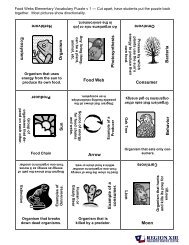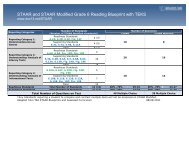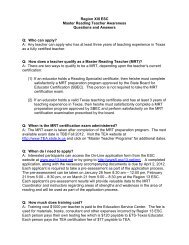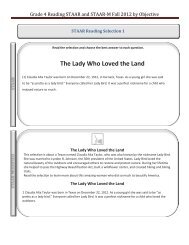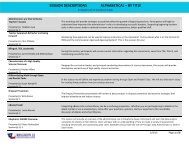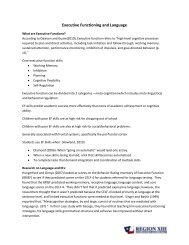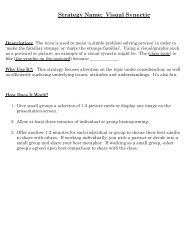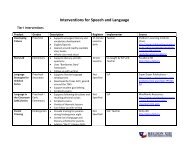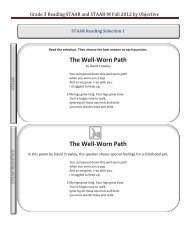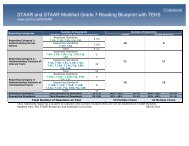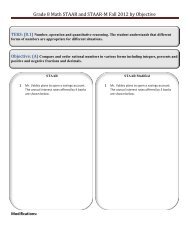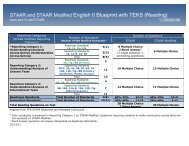2nd Six Weeks Newsletter - Region 13
2nd Six Weeks Newsletter - Region 13
2nd Six Weeks Newsletter - Region 13
You also want an ePaper? Increase the reach of your titles
YUMPU automatically turns print PDFs into web optimized ePapers that Google loves.
2010—2011 Second <strong>Six</strong> <strong>Weeks</strong> PreviewSocial StudiesKindergartenUnit 3: Family as Community. In this unit students focus on families as communities. They will investigate the customsand traditions of families to see how customs and traditions help define the culture of the families, meet individual needs,and create a bond based on common experience and shared values. To accomplish this, students compare traditionsand customs. The time concepts of past and present are introduced when students look at how families meet needs inthe present and compare them to ways families met needs in the past.Unit 4: Other Communities: Neighborhood. In this unit students focus on their town (or neighborhood community in anurban area). They identify the physical characteristics of their community and the relative location of those places in thecommunity. They learn about the rules of the community and the authority figures that enforce the rules.A community is a place where people live, work and play. Every community has physical and human characteristics ofplace. This unit examines the physical characteristics of place, helping students understand the physical environment ofthe community. Communities also have rules and authority figures to make and enforce those rules. A third element ofcommunities includes the customs and celebrations of the community that, like traditions and customs in a family, unite acommunity.1 st GradeUnit 3: Interacting with Others: Family. This unit looks at how people interact within a family unit as part of a community.Family members work together to meet basic needs, contributing to the family’s common good by furnishing goodsand services (including chores and jobs well done) for the family.The needs for each family (food, clothing, shelter, belonging and affection, order, safety and security, and conflict management)are met in different ways in different families. Family customs and traditions, including the telling of family andcultural stories, help families meet one basic need, the need to belong, by reinforcing what is important to the family/culture and the sense of common heritage and belonging.Unit 4: Interacting with Others: Community. In earlier units students learned how people interact at home and atschool. In this unit students learn about how people interact in the community. People live, work, and play in their communities,and people contribute to their communities. The lessons look at different ways people in the community interactwith each other and the community.In the lessons in this unit student will:Locate their community, the state, and nation and understand that the state is part of the country and the communityis part of the state.Look at authority figures in the community (after having studied authority figures in the home and school in earlierunits).Learn about leaders in the community, state and nation, comparing their positions and discussing roles of public officials.In this lesson students also apply geography skills they have learned so far this year.Look at Clara Barton, a good citizen from the past, and at local people (including modern-day people and themselves)who interact with their communities by contributing and taking responsibility for the common good.Look at symbols – symbols that represent our nation and state also represent our ideals our beliefs (freedom, rulesand laws, responsibility for the common good).These shared ideals create a bond in the community.2 nd GradeUnit 3: Physical Characteristics of Our Community. Students look at various levels of communities from their localcommunity to the world community in which they live. They investigate and identify major landforms within the worldcommunity and compare different communities to determine how the physical characteristics of a place affect the peopleliving in that community. Students will also expand their investigation of the landmarks in the local community and createa map depicting several of those landmarks.23



